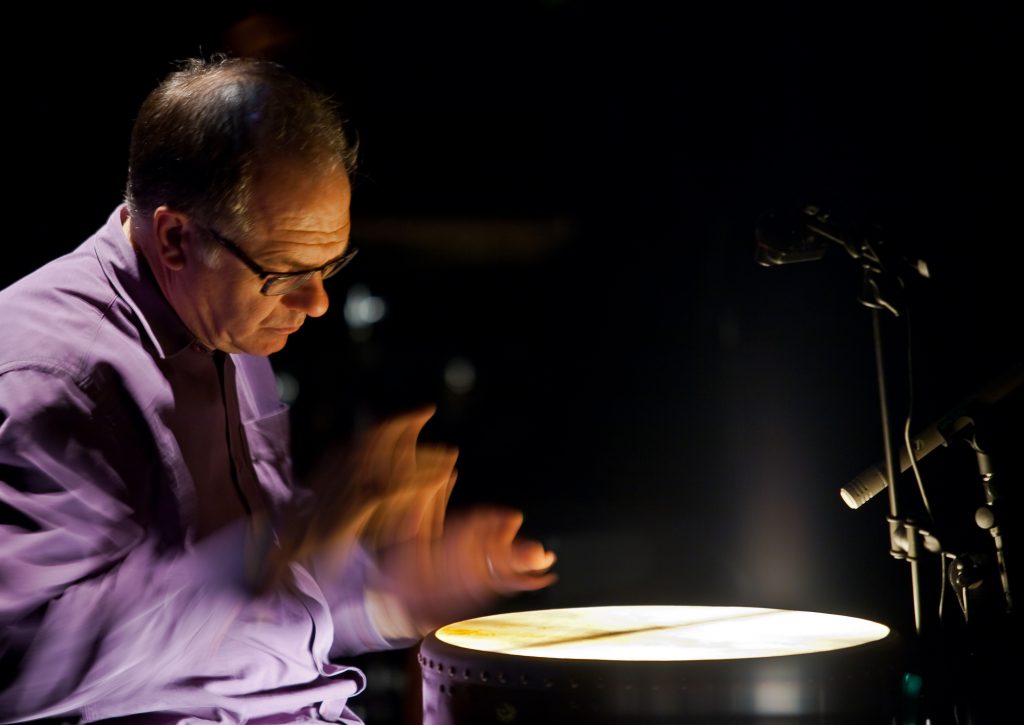UC San Diego: the Elysian Fields of Percussion Performance
When it comes to providing the sonic spectrum to which avant-garde music aspires, there is no doubt that the percussionist sits in the catbird seat. The extensive variety of sounds his battery can produce makes even a symphony orchestra sound monochromatic by comparison. Wednesday, February 27, at UC San Diego’s Conrad Prebys Concert Hall, virtuoso percussionist Steven Schick gave an impressive solo recital of recent works as part of the university’s week long “Cross-Wired,” a festival of concerts and masterclasses dedicated to cutting edge percussion music and its performers.

Steven Schick [photo (c.) Bill Dean]
A dramatic piece of performance art that requires the percussionist to give a highly charged interpretation of shards of poetry by Samuel Beckett while executing a complex, athletic score that calls for more than a dozen instruments, “Here and There” brings the Romantic art song kicking and screaming into the 21st Century. The primary station from which Schick worked had him sandwiched between a massive gong and a bass drum suspended horizontally, while the secondary station consisted of a vibraphone adorned with smaller hand-held noisemakers. Accompanying himself smartly on the güiro, he processed gracefully between each station.
Cleanly defined but vaguely ominous low sonorities from the bass drum and gong certainly fit the moody, existential poetry, but Schick was also able to scrape aptly jarring high-pitched tones from the outer edges of the gong, as well as the sharp clicks from the ever present güiro that both accompanied and blotted out lines of urgent text. I liked the way he dampened thunderous deep tones from the gong: he embraced it like a voluptuous lover.
Amid the almost industrial hard-edged sonic attacks of this piece, the vibraphone’s gossamer riffs and fluttering flourishes arrived as welcome contrast. Side lighting on a dark stage produced giant shadow figures of the performer on the hall’s slanted side walls, a fitting “Phantom of the Opera” bit of stagecraft. At 35 minutes, “Here and There” proved just the right length, thanks to Reynolds’ inventive score and Schick’s suave showmanship.
A much shorter but equally inventive work, Liang’s “Trans” struck me as a tightly structured etude of urgent, asymmetrical rhythmic themes. The shimmer of malleted cymbals held this array of percussion instruments together in the same way the string section makes a symphony cohere. Among the outstanding sounds, I appreciated the acute, brittle snap of the purple heart: very thin wooden planks placed in typical keyboard position and played with hard sticks and mallets.
The composer explained to me at the intermission that while he notated all the music quite precisely–i.e. there was no improvisation—the performer chose the instruments he used. Liang wrote the piece for Schick, and the performer wanted to be able to play it regardless of the specific percussion instruments available to him in any venue, so the composer left the orchestration to the performer. The results proved highly satisfying to this listener.
Celeste Oram’s cryptically titled piece looked like a seance with snare drum. Surrounded by some twenty transistor radios suspended just over his head, Schick sat in front of a snare drum, sometimes putting his ear to the head to listen to it and sometimes tapping out patterns with drumsticks. The radios started with an amusing cacophony of contrasting broadcast, but soon pulied back to a buzzing white noise. Later Schick took a specially marked seat in the audience and communicated in quotidian conversation with the voice that came to him through the sound system (the composer?). This clever work brought enthusiastic cheers form the audience.
Schick told the audience he had been playing Stockhausen’s “Zyklus” over the span of his career, and he presented it as an homage to one of the touchstone avant-gardists of the last century. Its explosive marimba riffs, assertive drumming, and cool sprays from the vibraphone made it sound surprisingly contemporary. Schick made “Zyklus”—and all of the works on the program—appear sleek and nonchalant. Only the unrelenting, kaleidoscopic blasts of sounds reminded us how much art and craft went into creating his demanding performance.
This program was presented by UC San Diego’s Division of Arts and Humanities at the Conrad Prebys Concert Hall on February 27, 2019. The “Cross-Wired” festival continues through March 1, 2019 at UC San Diego.


